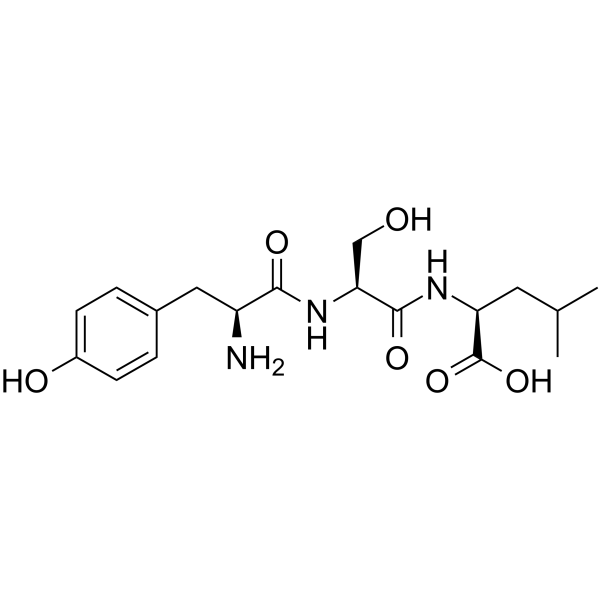上海金畔生物科技有限公司为生命科学和医药研发人员提供生物活性分子抑制剂、激动剂、特异性抑制剂、化合物库、重组蛋白,专注于信号通路和疾病研究领域。
Tyroserleutide (Synonyms: 酪丝亮肽)
Tyroserleutide (YSL),可从猪脾脏的降解产物中分离得到,是一种小分子三肽,在体内外均可抑制肿瘤生长。
Tyroserleutide Chemical Structure
CAS No. : 138168-48-6
| 规格 |
|
是否有货 |
|
| 100 mg |
|
询价 |
|
| 250 mg |
|
询价 |
|
| 500 mg |
|
询价 |
|
* Please select Quantity before adding items.
Tyroserleutide 的其他形式现货产品:
Tyroserleutide hydrochloride
| 生物活性 |
Tyroserleutide (YSL), isolated from the degradation products of porcine spleen[1], is a small molecular tripeptide which inhibits tumor growth both in vitro and in vivo[2].
|
IC50 & Target |
Antitumor tripeptide[1][2]
|
体外研究
(In Vitro) |
Tyroserleutide (YSL) exhibits immuno-modulating effects, such as enhancing concanavalin (ConA) induced proliferation of mouse spleen lymphocytes, phagocytosis of mouse peritoneal macrophages, and the activity of natural killer (NK) cells[1].
Tyroserleutide (YSL), an immunologically therapeutic tripeptide, can promote hepatocarcinoma cell (H22) apoptosis through downregulating Bcl-2 and cyclin D1 expression[2].
Tyroserleutide is an ideal choice for inducing apoptosis of liver tumor cells[2].
Tyroserleutide inhibits tumor growth and does not cause severe toxicities in the major organs. Tyroserleutide can inhibit tumor cell migration[2].
Shanghai Jinpan Biotech Co Ltd has not independently confirmed the accuracy of these methods. They are for reference only.
|
体内研究
(In Vivo) |
Tyroserleutide (10-80 μg/kg; injection (i.p.) one time every day until mice are dead) displays obvious anti-tumor activity. Tyroserleutide significantly prolongs the survival time of the murine H22 implanted mice[1].
Shanghai Jinpan Biotech Co Ltd has not independently confirmed the accuracy of these methods. They are for reference only.
| Animal Model: |
Female Kun-Ming mice (18-22 g, 6 week old) with H22 tumor model[1] |
| Dosage: |
10, 20, 40, and 80 μg/kg |
| Administration: |
Injection (i.p.) one time every day until mice were dead. |
| Result: |
Survival times are 25.53±14.14, 25.82±14.29, 30.47±17.89, 35.06±20.90 days for 10, 20, 40, and 80 μg/kg, respectively. |
|
| Clinical Trial |
|
| 分子量 |
|
| Formula |
|
| CAS 号 |
|
| 中文名称 |
|
| 运输条件 |
Room temperature in continental US; may vary elsewhere.
|
| 储存方式 |
Please store the product under the recommended conditions in the Certificate of Analysis.
|
| Solvent & Solubility |
In Vitro:
H2O
Peptide Solubility and Storage Guidelines:
1. Calculate the length of the peptide.
2. Calculate the overall charge of the entire peptide according to the following table:
| |
Contents |
Assign value |
| Acidic amino acid |
Asp (D), Glu (E), and the C-terminal -COOH. |
-1 |
| Basic amino acid |
Arg (R), Lys (K), His (H), and the N-terminal -NH2 |
+1 |
| Neutral amino acid |
Gly (G), Ala (A), Leu (L), Ile (I), Val (V), Cys (C), Met (M), Thr (T), Ser (S), Phe (F), Tyr (Y), Trp (W), Pro (P), Asn (N), Gln (Q) |
0 |
3. Recommended solution:
| Overall charge of peptide |
Details |
| Negative (<0) |
1. Try to dissolve the peptide in water first.
2. If water fails, add NH4OH (<50 μL).
3. If the peptide still does not dissolve, add DMSO (50-100 μL) to solubilize the peptide. |
| Positive (>0) |
1. Try to dissolve the peptide in water first.
2. If water fails, try dissolving the peptide in a 10%-30% acetic acid solution.
3. If the peptide still does not dissolve, try dissolving the peptide in a small amount of DMSO. |
| Zero (=0) |
1. Try to dissolve the peptide in organic solvent (acetonitrile, methanol, etc.) first.
2. For very hydrophobic peptides, try dissolving the peptide in a small amount of DMSO, and then dilute the solution with water to the desired concentration. |
|
| 参考文献 |
-
[1]. Wang C, et al. Studies on the large scale synthesis and anti-tumor activity of YSL. Prep Biochem Biotechnol. 2003 Aug;33(3):189-95.
[2]. Liang P, et al. pH-Triggered Conformational Change of Antp-Based Drug Delivery Platform for Tumor Treatment with Combined Photothermal Therapy and Chemotherapy. Adv Healthc Mater. 2019 Aug;8(15):e1900306.
|
所有产品仅用作科学研究或药证申报,我们不为任何个人用途提供产品和服务

